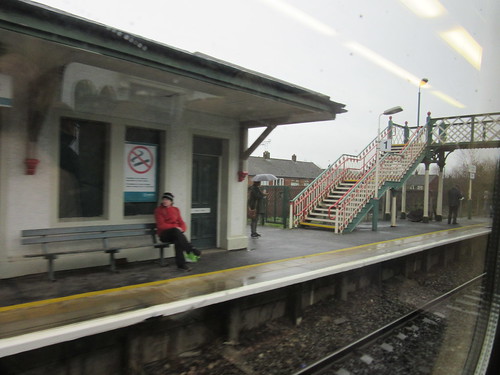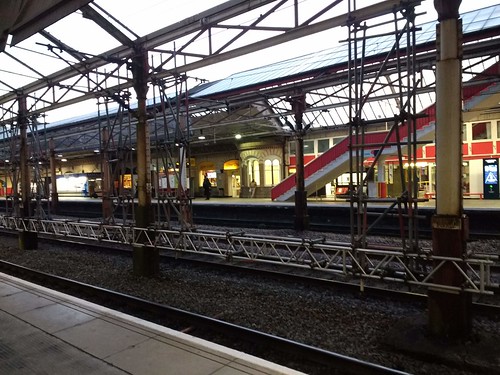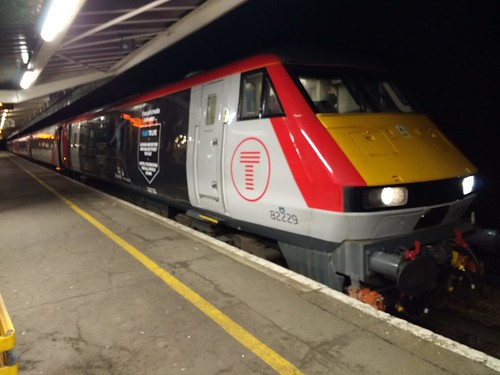
Gradient diagram Crewe - Holyhead
Click for larger view
In the age of Covid, travelling by rail is a rather changed experience. During the Coronavirus Pandemic, rail passenger numbers are around half of normal, with 'emergency timetables' in use and increased likelihood of train cancellation at short notice as staff 'self-isolate' following positive tests for Covid-19. Since Welsh Devolution, certain matters, including Public Health, are devolved to Cardiff so some laws in England and Wales differ, complicating running a UK-wide railway system.
Fflint 11th January
Following devolution the Welsh spelling 'Fflint' is normally used, rather than the English 'Flint'. Previously, I'd been through the town by road many times, once stopping to visit the ruined castle (Flint Castle). On many rail journeys into Wales I'd passed through the station, but this was to be the first time I'd boarded a train there. I'd previously looked up the 'emergency timetable' to determine the available services, depending on what time the business meeting finished. I was unlikely to finish in time to catch an Avanti 'Voyager' service from Holyhead to Crewe. Later services were Transport for Wales (TfW) Diesel Multiple Unit (DMU) and involved a change at Chester for either the DMU shuttle to Crewe or, alternatively, a TfW service via the former Great Western route through Wrexham and Shrewsbury. Some TfW services from Fflint didn't require a change at Chester as the train reversed direction at Chester, retracing the incoming route back to Saltney Junction before diverging onto the Wrexham route.
I was given a lift to Fflint station after the meeting. The 2-storey main station building on the Down side, next to the modern car park, looked interesting but, with the passenger displays showing '15:28' actual time and the 15:29 departure to Chester reported as 'On time', I decided to postpone both studying the architecture and purchasing a ticket. I hurried through the building onto the plaform and ascended the steps of the LNWR-pattern footbridge to reach the up platform, with its single-storey station building, as the 2-coach 'Sprinter' operating from Llandudno Junction to Manchester rolled to a stop.

North Wales Line (Crewe - Llandudno): Up side station building and footbridge at Fflint in 2016.
I boarded the train which departed immediately, with one intermediate stop at Shotton Low Level, arriving at Chester 'right time' at 15:48 which left me six minutes to cross the footbridge to platform 1 where a TfW 'Supersprinter' provided the non-stop DMU shuttle to Crewe. We made another on-time arrival at 16:19 in platform 9 at Crewe. The next departure to Wolverhampton was not until 16:53 when the West Midland Trains Electric Multiple Unit (EMU) service from Liverpool Lime Street to Birmingham was due to make a stop. That gave me plenty of time to go to the modern 'gate line' on the overbridge and purchase a Fflint - Wolverhampton ticket from the three friendly ladies manning the ticket barrier.
The station was dark and rather cold so when I discovered a Liverpool-London Avanti 'Pendolino', due in a few minutes, called at Stafford, I decided to abandon platform 6 (for the Liverpool-Birmingham) and use the overbridge to reach platforms 1 to 5 to board this earlier train, alighting at Stafford to wait for the West Midland Trains service to catch up.
Walking along platform 5 from the overbridge, I just had time to record some scaffolding which had been erected around three of the cast-iron columns supporting trusses for the overall roof.

Crewe: Repairs to roof supports
I've always admired the complex overall roof at Crewe, which I've assumed dated from the major extensions to the station carried out by the LNWR around 1900, although now heavily modified. During electrification of the line, the cast columns supporting the roof were externally clad for strength and some of the columns were given a second role as anchor points for the Overhead Line Equipment, as shown in the picture below

In 2013, a Manchester-bound 'Pendolino' arrives in Platform 5 at Crewe. Note Overhead Line Equipment mounted on strengthened columns supporting the overall roof trusses.
I assumed that the scaffolding was in connection with further reinforcement for the cast colums but I hastened to platform 1 where the London-bound 'Pendolino' was quietly stopping.
One other passenger and I boarded the last coach, a 'Quiet' coach. We were the only occupants. The fast journey to Stafford, taking only 20 minutes, was very relaxing compared with the ambient noise in the two previous DMU trains. I changed my plans and decided to get a taxi home from Stafford, rather than Wolverhampton - a longer mileage but it would save time
Rhyl 27th January
After the meeting at Saint Asaph, I was given a lift to Rhyl station, with 30 minutes to wait for a train. Although I'd travelled through Rhyl many times, it had probably been half a century since I set foot there. The buildings have been renovated and I was able to purchase a ticket at the staffed ticket office before passing through the modern automatic ticket barrier onto the platform to wait for the 17:44 departure. The former importance of Rhyl as a tourist destination was apparent from the width of the platform and the extensive station buildings. The simplification of the once-complex track arrangements has left only two through platforms facing one another across the space where once non-stopping trains thundered past on 'fast' lines. The Down 'fast' remains but the Up 'fast' has been removed. Fully modernised signalling now extends through Rhyl, currently as far as Abergele, with partially-updated traditional methods beyond to Holyhead.

Rhyl station. Platform 1 looking towards Holyhead
The width of the steps leading to the footbridge again testified to the large numbers of holiday-makers once handled at this station.

The broad steps to the passenger footbridge at Rhyl station.
I couldn't resist ascending the steps to confirm the width of the passenger walkway. This is divided by a girder from a similar, parallel baggage bridge provided with lift towers on the two platforms installed to raise and lower the once-needed procession of trollies of passengers' luggage, parcels and post using electric lifts (elevators). I was amused by the short ladder installed to allow station staff to climb over the dividing girder to reach the upper door of the lift, remembering how often lifts of that period failed to respond to the call button because a manual lift gate had not been properly closed. I was also rather surprised that the ladder, as an obstruction to the free-flow of passengers on the bridge, had survived in our age of Health and Safety. Clearly, they're not now expecting the crowds of excited trippers I remember from my childhood excursions.

Footbridge at Rhyl station
It was already dark, so I heard my approaching train before I saw it. I was puzzled by the throaty rumble of a large diesel, rather than the sound of a DMU which I had expected. As the train slowly entered the platform I was surprised to see a Class 67 leading a short train of modern-looking coaches and what appeared to be a Driving Van Trailer (DVT) at the rear, all in the TfW livery and looking rather smart. I followed the group of passengers onto the train and, in the unfamiliar coaching stock, found myself in first class. A pleasant buffet car attendant shooed us all out of first class into the rest of the train and I settled in the Mark IV buffet car adjacent.
I started to remember that, following Welsh Devolution, some elected members of the Welsh Senedd which sits in Cardiff had complained of poor transport connections making it hard for them to travel to-and-from their constituencies, particularly in North Wales. A little later, Arriva Trains Wales had leased some Class 67 locomotives and passenger coaches (all decked out in Arriva Trains Wales blue livery) and a service had been started between Holyhead and Cardiff, routed via Chester, Crewe, Shrewsbury and Hereford. I'd occasionally seen signs of this innovation around Crewe. Later, Arriva Trains Wales had later added a Driving Van Trailer (DVT) to each trainset, allowing push-pull working. This allowed the routing to be changed to Holyhead-Chester(reverse)-Wrexham-Shrewsbury-Hereford-Cardiff. In October 2020, the Welsh Devolved Government had privatised the Wales and Borders rail franchise, following the adverse impact of the Coronavirus pandemic. What I'd not realised was that, in 2021, the Holyhead-Cardiff service, offered as 'TfW Premium Service' was re-vamped, using Mark IV coaching stock and DVT.
Since the buffet was open, I indulged in a sandwich which was made to order and delivered to my seat - a very old-fashioned touch. We stopped at Prestatyn and Fflint before arriving in platform 3 at Chester. As expected, we reversed direction here, now being driven from the DVT the two miles back to Saltney Junction where we diverged onto the former Great Western route, making stops at Wrexham General, Ruabon, Chirk and Gobowen before arriving at Shrewsbury at 19:21. I left the 'Premier Service' here for my final leg back to Wolverhampton, another TfW service provided by a DMU already waiting in platform 5, ready to leave at 19:32.

Mark 4 Driving Van Trailer of Transport for Wales 'Premier Service' from Holyhead to Cardiff at Shrewsbury
History Notes
When I was young, Great Britain (England, Scotland and Wales) operated as a relatively unified whole, although Scotland retains a different legal system and Scottish banks can issue their own banknotes still denominated in pounds Sterling. Northern Ireland's less-happy history resulted from various attempts at dealing with demands for Irish independence and it has its own parliament in uneasy liason with the Westminster parliament. England, Scotland, Wales and Northern Ireland together form the United Kingdom (UK). The UK joined the European Economic Community (EEC) in 1973 and this choice was confirmed in the 1975 Referendum. The Maastricht treaty, effective 1993, changed the EEC into the European Union (EU). In 1997, following Welsh and Scottish referendums, the UK Labour government devolved certain powers to separate parliaments in Cardiff and Edinburgh. The nature of the EU and its management was further changed by international treaties in Amsterdam (in force 1999), Nice (in force 2003) and Lisbon (in force 2009). This led to a further ill-tempered UK referendum in 2016 which voted to leave the European Union and this occured formally on 1st January 2021. The four constituents of the UK (England, Scotland, Wales and Northern Ireland) are nowadays sometimes referred to as the 'Home Nations'. Confusing, isn't it?
Related posts on other websites
Links to external sites are correct at time of publication but, with time, may become broken.
Flint Castle (Wikipedia)
Premier Service (Wikipedia)
Driving Van Trailer (Wikipedia)
TfW Premium Trains br>
Related posts on this website
Railways at Crewe in the '50s
Crewe Station
My pictures
North Wales Line (Crewe - Llandudno, various dates
Crewe Area rail, various dates
Crewe Station Buildings: L&NWR
Shrewsbury area railways
[Minor edit 4-Mar-2022]
